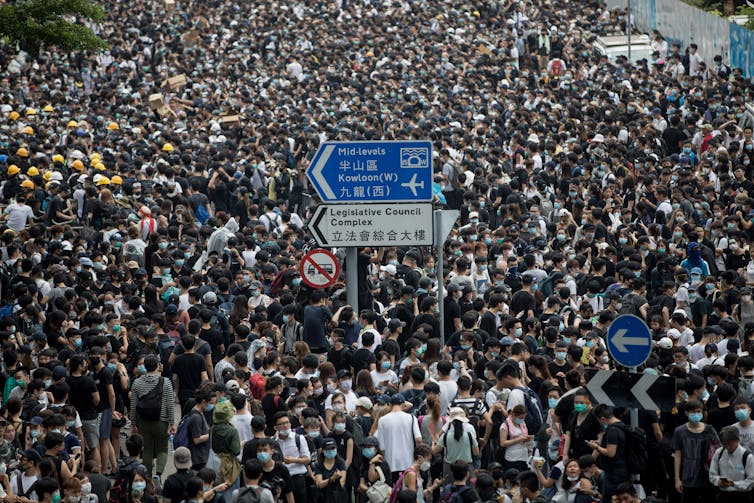The dramatic protests unfolding in Hong Kong evoke memories of the most sensational episodes of the country’s “umbrella movement” five years ago at the very same sites. At the end of the unprecedented 79 days occupation in 2014, demanding genuine universal suffrage, protesters vowed to be back. Few would have expected that it would be so quick and with such vengeance.
A mass demonstration on June 9 was followed by protests three days later that shut down streets around government buildings as police fired rubber bullets at protesters. The demonstrations were triggered by the decision of the Hong Kong Special Administrative Region government to propose amendments to its extradition bill. This would allow extraditions to new areas such as Taiwan and Macau, but more importantly the People’s Republic of China.
Hong Kong’s chief executive, Carrie Lam, argued that the “loophole” in the law must urgently be closed to allow the transfer of a fugitive wanted for murder in Taiwan before he could leave Hong Kong.
But the “loophole” was deliberately included during the Sino-British negotiations in the 1980s over the transfer of sovereignty of Hong Kong from the UK to China in 1997. After 1997, Hong Kong residents and businesses were guaranteed the rule of law and shielded from the party-controlled judicial system across the border. Fortunately, over the past decades, rule of law has differentiated Hong Kong from the Chinese mainland. Among 125 jurisdictions examined by the World Justice Project in its 2019 Rule of Law Index, Hong Kong was ranked 16th and mainland China 82nd.
Read more: Hong Kong in crisis over relationship with China – and there does not appear to be a good solution
Rushed legislation
The recent demonstrations are the largest in Hong Kong’s post-1997 history, uniting people of different generations, occupations and interests in a way comparable only to the protests in Hong Kong against the Tiananmen massacre in 1989. Anger and despair are widespread and so is a sense of powerlessness at the way the relationship between Hong Kong and China has dramatically changed during the past five years.
The initial details of the extradition proposals heightened fears that the long arm of the Chinese law was reaching further into Hong Kong. It would enter the territory into extradition arrangements with China on a case-by-case basis, in which the chief executive has the sole power to surrender fugitives to China without the need to consult Hong Kong’s Legislative Council.
Critics such as Lam Wing Kee, a Hong Kong bookseller targeted by the Chinese authorities, have pointed out the dangers of such a set-up. Lam left Hong Kong for Taiwan in April over fears that once the bill passed, Beijing would demand his immediate extradition.

Fears were further exacerbated by news the government wanted to rush the law through before the Legislative Council session ends in July. The pro-Beijing majority in the legislature pushed the bill quickly through its committee stages in an attempt to avoid proper legislative scrutiny. While the second reading of the bill was postponed by the protests, Lam still plans to go ahead with it. Once the bill reaches the voting stages it will be passed by the pro-Beijing majority.
The legislative process reveals how the government and its pro-Beijing allies are using the non-democratic and partisan nature of Hong Kong’s institutions to give the appearance of democracy. Law-making power is concentrated with the chief executive, who is selected by a committee of merely 1,200 of Hong Kong’s 7.4m citizens. Only half of the Legislative Council is directly elected and pro-Beijing legislators enjoy a structural majority. Since the 2014 umbrella protests even previously neutral bodies, such as the well-respected civil service and police force, have become politicised.
China’s growing confidence
Hong Kong’s status as an international financial centre is still of great importance to China and its ruling elite, providing access to crucial financial services unattainable in Shanghai and Shenzhen. But Hong Kong’s role as a model for economic development in China has diminished as the regime grows ever more confident in its own brand of state capitalism. Previous mass protests in Hong Kongin 2003 and 2004 against national security legislation were partially successful, and a proposed bill was postponed. At that time, the Beijing regime still valued international perceptions and even promised the territory further democratisation.
This has changed as China has also become significantly more confident as a rising global power. Under the leadership of Chinese president, Xi Jinping, Hong Kong has been at the receiving end of this new confidence. Since the umbrella movement, the Hong Kong government has been supported by the Chinese government to gradually shut down various avenues for dissent and opposition. After the umbrella movement, the frustrations of the younger generation over China’s policies towards Hong Kong were channelled into a movement, known as “localism” asking for more political, economic and cultural autonomy from China. Yet its proponents were disqualified from office, barred from running in elections or outlawed. The leadership was imprisoned or driven into exile.
The simple act of rallying is now easily interpreted as a criminal act, using Hong Kong’s outdated Public Order Ordinance. The Hong Kong police commissioner has already labelled the current protest as a “riot” and justified the escalated use of police force against protesters. It is the same “rioting” charge under which localist leader Edward Leung Tin-kei was sentenced to six years of prison in 2018.
What is being observed in Hong Kong is now a collective expression of anger towards the extradition law and the government, distrust of the Chinese government and, crucially, an unwavering search for hope.

